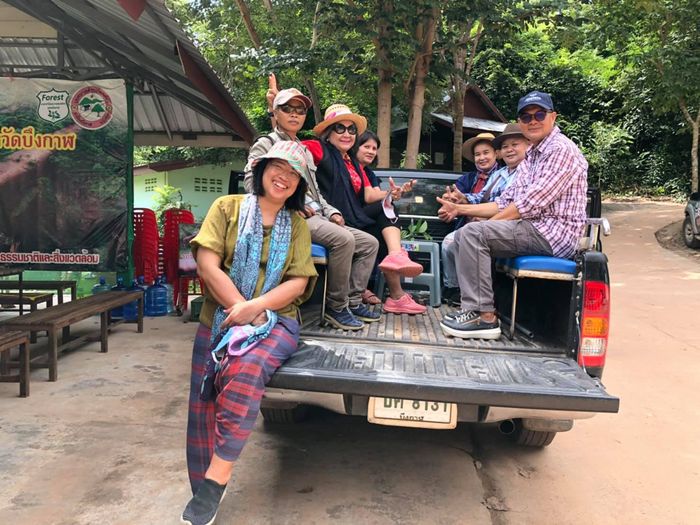At a time when economies have been suffering severely in the COVID-19 crisis and international travel has almost come to a halt, domestic tourism is seen as an opportunity and as a way out. We asked tourism players from Thailand how their country is managing and how community-based tourism (CBT) is faring.
Chuta Tharachai
Chuta Tharachai, Ph.D, is Director of the Northern Region Office, (Thailand Convention and Exhibition Bureau - TCEB
Nithi Subhongsang
Nithi Subhongsang is Managing Director of Nutty’s Adventures, Ayutthaya – a tour operator supporting CBT with a focus on “Tourism for All” that makes tours available to people with physical disabilities, e.g. wheelchair users and the blind.
Parichat Suntararak
Parichat Suntararak is the owner of Paree Travel, a small tour operator focusing on CBT, secretary of the Thai Ecotourism and Adventure Travel Association (TEATA) and Ph.D. candidate in Tourism Management at the National Institute of Development Administration (NIDA), Bangkok.
What is the COVID-19 situation in Thailand at the moment?
Chuta Tharachai: COVID-19 became widespread in March and many public venues and businesses were ordered to close. On March 26th, the Prime Minister declared a state of emergency and mobility became restricted. Thailand controlled international transmission by suspending all commercial international flights and soon the country entered full lockdown mode. The number of new infections per day was brought under control, with single digits. Eventually, government restrictions were gradually eased. Now Thailand is cited in various sources for COVID best practices. The success, however, is the great sacrifice of the national economy, particularly in the tourism sector.
What happened to the tourism sector?
Chuta Tharachai: In 2019, tourism in Thailand generated about 20 percent of GDP and 8.3 million jobs. International arrivals dropped to zero since April, which hurt everyone in the tourism value chain. The government offered various stimulus measures, including interest-free loans for affected businesses. While international arrivals are still uncertain, domestic tourism seems to be the only way for industry to survive.
Parichat Suntararak: Surprisingly, in 2019 domestic tourists made 167 million trips, much more than the 39.8 million of foreign arrivals. Domestic tourism contributed up to 35.8 percent of total revenue in the past three years. However, domestic tourists spend less per day and the trips are shorter. The number of trips is still lower compared to the previous year, but there are clear signs of recovery. The hotel occupancy rate increased from 13 percent in June to nearly 28 percent in September 2020.
Nithi Subhongsang: Community-Based Tourism has perhaps been less seriously affected than some other sectors. Location and activities offered have determined the extent to which any given community has suffered. Communities that relied on overseas visitors have experienced a huge drop in income. A few domestic tourists visit from time to time, but their spending is rather low, as they often visit just for the day. City-dwelling Thais like to visit rural communities and learn about their ways of life, but any homestays need to be of a very high standard. Most domestic visitors choose to stay at nearby resorts or hotels.
Is there special support of domestic tourism?
Parichat Suntararak: The government launched a ‘We Travel Together’ campaign. Free trips are provided to 1.2 million medical personnel and health volunteers while other holidaymakers enjoy subsidies for hotel rooms, meals, and transport. At 40 percent of usual room rates, the government subsidizes five million nights of hotel accommodation. The other 60 percent must be paid by the visitors. In addition, public holidays have been added to create four-day weekends in July, October, November, and December 2020 to encourage people to travel more.
Do community-based tourism projects also benefit?
Parichat Suntararak: Rural tourism has not been left behind. Community-based tourism has become a national tourism strategy and while tourism is low, the government takes it as opportunities for local communities to upgrade themselves. New campaigns were launched to promote tourism in rural areas and to boost the quality of domestic community tourism and build trust and recognition among the various target tourists.
The Ministry of Tourism and Sports launched ‘Healthy Homestay and Safe Community-Based Tourism’ to promote the new normal and help bring more income to the villages. The campaign targets the increasing number of health-conscious tourists. It encourages villagers to add health elements to their services offered, including a healthy food menu, meditation classes, or herbal medicines.
Nithi Subhongsang: Many communities serve as learning centres for others, and groups of community representatives come from all over the country to learn from their experiences. Since COVID, government agencies have been channelling much of their budget into organising more study trips and using this quiet period to strengthen the base of CBT throughout the country. The number of study trips this year is comparable to last year and an increase is expected for 2021.
Chuta Tharachai: The Thailand Convention and Exhibition Bureau (TCEB) is promoting community-based MICE (Meetings, Incentives, Conferences, Exhibitions). If a village is easily accessible and its space allows for group activities, it is promoted as a MICE destination. Otherwise local skills such as silk weaving can be demonstrated at hotels or in-town venues.
Were the incentives successful in stimulating domestic tourism
Nithi Subhongsang: Only partially. Despite gradual economic recovery the volume of domestic tourism is still considerably lower than before the lockdown. During a time of economic hardship when money is tight, holidays are not a priority for many people. Many popular tourist attractions for Thai people, such as Pattaya, Phuket, Samui, Chiang Mai, are still being forced to reduce prices as the purchasing power of domestic tourists is less than half of that of overseas tourists
What do you expect the future to look like?
Parichat Suntararak: Now we can travel freely inside the country. However, tourism will not be the same. We need to adapt to the ‘new normal’ practices where we need to maintain social distancing and safety precautions such as wearing masks and regular hand washing wherever we go. We are still in the unknown, we never know when the situation will return to normal. At least, not until a vaccine is rolled out. We must not lower our guard.
Nithi Subhongsang: While the outlook in all of our major tourism markets is still very bleak, the Thai government will not open up the country to overseas visitors. We must adapt and find new business opportunities. When our overseas visitors do return, many of them will be looking to avoid large resorts and crowds and will instead be choosing to escape to smaller, quieter destinations and to travel in smaller groups, just with family or friends.
Chuta Tharachai: In a way, COVID allows Thailand to revisit its own tourism market. By re-designing domestic tourism structures, adjusting both demand and supply, we see great opportunities ahead. We are confident that localization will help lessen overdependence on international arrivals and gradually strengthen domestic consumption. More importantly, it can strengthen local communities by including them in tourism value chain based on their local assets. The new chapter of domestic tourism will hopefully help Thailand to emerge safer, stronger and more sustainable.
Jaranya Daengnoy is Director of the Thailand Community Based Tourism Institute (CBT-I) in Bangkok with 20 years of experience as a CBT activist.



![[Translate to english:] Chuta Tharachai](/fileadmin/tourismwatch/_processed_/d/a/csm_TW103_-_Thailand_-_Chuta_Quelle_privat_cb4721734d.jpeg)


